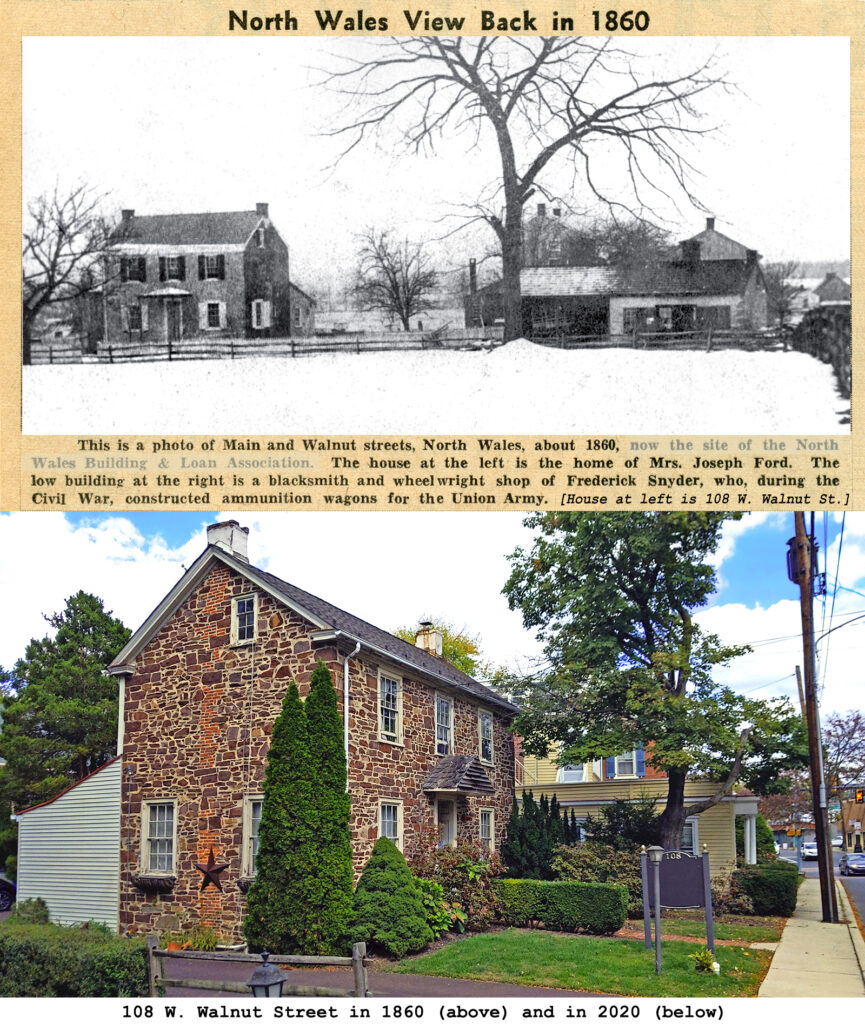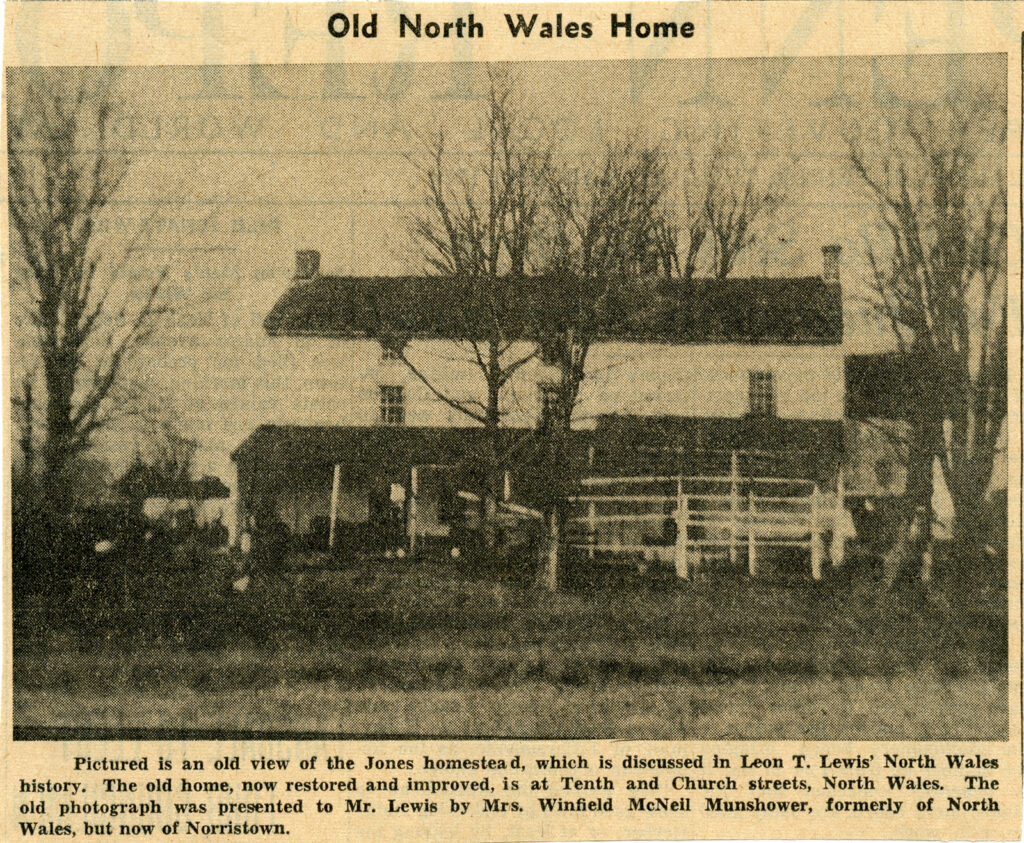In 1734, five persons by the name of Jones are mentioned as among the taxables of Gwynedd, including John Jones, son of Robert, so given to distinguish him from John Jones, the penman, and John Jones, the weaver. The others were Cadwalader Jones and Hugh Jones. Possibly the two latter were the other sons of Robert, and inherited the remaining land. A deed of 1760 to George Weidner is witnessed by Roland Evans, Joseph Lukens and H. Vanderslice, before Justice Archibald McLean. The amount paid for the 187 acres was 545 pounds and 17 shillings. How long George Weidner thereafter held the farm we have no means of knowing, but by a subsequent document of 1784, it appears that Jacob Weyant then owned it and at that date sold of a portion comprising twenty-nine acres to William Rex, of Gwynedd. This was taken off the southwestern part.
From the above it will be seen that the original tract of 720 acres, patented to Robert Jones, extended for over two miles in length across Gwynedd, or more than two-thirds of the whole township from Montgomery to Whitpain townships. The breadth of this was something over a half mile.

It is somewhat difficult to fix the northeast boundary, but it is supposed to have been near the present road running from Lansdale (Hancock street) to State road (Route 202), and extending nearly to the Whitpain border. Just above this oblong tract was one still longer and much more narrow, lying across Gwynedd, patented to Evans Hugh (sometimes spelled Pugh). All above, to the Towamencin line, was patented to William Jones, while below, as before mentioned, lay the grants owned by various members of the Evans family, Thomas, Cadwalader, Owen, and Robert.
The will of Robert John is interesting. In his will, he bequeaths to his only son, John, 300 acres, “on which I now reside,” out of which he was to pay two pounds, ten shillings yearly to his mother. There was more land than this that John Jones received from his father. This was “all that part of the tract of land lately bought of Cadwalader Foulke. which lieth to the east side of The Great Road, containing 185 acres, with all the improvements thereon,” out of which he was to pay six pounds annually to his sister, Ellen. This daughter also received some real estate being “the remainder of the said land bought of Foulke, being divided therefrom by The Great Road,” amounting to 150 acres, indicating that the land was on the westerly side of it. It was provided that John might acquire said 150 acres by paying his sister 200 pounds for it.
The will also bequeaths to his daughter “a case of drawers and table, both standing in the new house, and also chamber and white ware.” This shows that Robert John, before his death, had built two houses on this land. It would be interesting to know the exact site of these two dwellings of the pioneer. In 1758, John Jones sold 120½ acres to Abraham Lukens, Sr. In 1760, two years later, as already mentioned, Jones sold 186 acres, lying on the opposite side of the Great Road to George Weidner, and thus, the last of the plantation that John Jones received from his father, passed from his hands.
Almost immediately, the same year, 1758, Abraham Lukens, Sr., sold 80 acres of the tract to his son Abraham Lukens, Jr. Fourteen years later, in 1772, the elder Lukens sold 50 acres on the southwest corner to Philip Heist, and in the same year, Abraham Lukens, Jr. sold 70 acres more to Philip Heist. (This is the land occupied now by Merrybrook, including the old colonial stone house now occupied by Chase R. Whitaker, on the Sumneytown pike.)
This furnishes nearly a complete history of the territory upon which modern North Wales now stands. The name “North Wales” is the translation of the Welsh word “Gwyneth” and from which Elias Clark, the general agent of the North Penn Railroad got the name of “Gwynedd.” It is the name of a river in Wales, U.K.
North Wales, the fifth of the county’s boroughs to be incorporated is situated, as was stated before, in the middle of a countryside whose settlement dates back to early Colonial times, but as a community, North Wales came into existence as the result of the building of the North Pennsylvania Railroad [today’s SEPTA Lansdale-Doylestown line]. When the railroad was opened in 1857, the little community included only a dozen houses and a distillery.
Preceding boroughs had been established by acts of the State Legislature. North Wales was the first in the county to be incorporated by the county court.
In 1849, which is about ten years before the railroad came through and twenty years before the incorporation of the borough, research shows that in what is now the borough limits, and its immediate vicinity, there was then only the farm house of Philip Hurst, the oldest in town, and where now stands the Rorer-Seems Building [3rd and Walnut]; the farm house of Jacob Booz, now the residence of George B. Burpee; the Shearer homestead, now an apartment house at Pennsylvania and Shearer streets; the Schwenk Homestead at Main and School, now occupied by the Reformed Church and private residences; the Miller place, the ground upon which now stands the home of Benjamin Miller; a long house near the parking lot of the Montgomery Bank and Trust Company (the foundations of which were unearthed when the bank building was recently remodeled); a tenement on the site of the home of Frank Rea; the Beaver farm house, now the home of Mrs. Harvey Baer; the Schwenk farm, now the Gordon Tract [today’s Parkside Place].
Of those mentioned, the Hurts, Booz, Miller and Beaver Tracts were along The Great North Wales Road, opened on an old Indian trail, and it was along this road that Ross Gordon, the then-owner of the Gordon Tract, commenced building the Spring-house and Sumneytown Turnpike, finishing it in 1849.
As stated above, when the railroad was built across the Sumneytown Pike, it was evident that this would be a fine place to start a new town, and soon after trains began running, in 1856, a hotel was built, then stores and dwellings. (A post office was opened for the hamlet in 1864. Its first name was Gwynedd, but after a few years the name was changed to North Wales.) The train station was first located on the east side of the single-track railroad, between Main and Second streets. The land for the station was donated by squire Algernon Jenkins in 1857. The first station was a one story affair and was used as both a passenger depot and freight house. The first locomotive on the railroad was called The Civilizer. The steam engine was pulled overland, above the tunnel still under construction, on a temporary track so that the railroad north of the tunnel could be completed.
Next month we will resume our story.
This post is sourced from a column entitled Early North Wales: Its History and Its People penned by long-time North Wales resident historian Leon T. Lewis. The article appeared in its original form in the March 17, 1959 issue of the North Penn Reporter.

